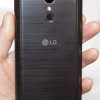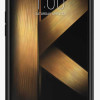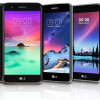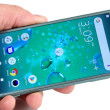Review: LG K20 V for Verizon Wireless
Lock Screen
The K20 V doesn't have an always-on display, but it does have LG's KnockOn and Knock Code for waking and unlocking the phone.

KnockOn will wake the display whenever you double tap the K20 V's display. It reveals the clock/notification combo at the top of the screen, in addition to shortcuts for the phone and the camera in the bottom corners. KnockOn is most helpful when the phone is sitting on a table or desk. KnockCode is a bit more complex. It's a security tool you can opt to use for waking and unlocking the phone in one step through a custom pattern of taps. LG's software walks you through the process of recording a pattern.
I like that the lock screen clock is easy to read thanks to the large font. Users can fine-tune notifications for each individual app on the phone, which means plenty of control over what pops up in the screen, and when.
Security options include PIN, pattern, password, and print. The fingerprint reader is easy to train. It takes about a minute to setup each print. The reader is quick and accurate.
Home Screen
The K20 V runs Android 7 Nougat with LG's user interface on top. When you first fire up a new K20 V, the home screen panels are crammed with Verizon Wireless apps, widgets, and shortcuts.

By default there's no app drawer, so all the installed apps are in folders on the home screens. You can turn on the app drawer if you prefer a cleaner home screen experience. I appreciate that apps can be arranged in a denser grid (4x5) on the home screen. This lets you make more effective use of the screen's real estate.
The LG app drawer is as powerful as ever. It allows you to hide apps you know you won't use often (cough, Verizon bloatware, cough), and bring them back when needed. You can always sort apps to appear alphabetically, by frequency, or by install date.
Home Screens - With App Drawer
The phone lets you rearrange the back, home, and app switcher buttons at the bottom of the screen. This can be helpful if you're coming from a Samsung handset. The phone supports up to five buttons down there, including special LG options such as a button for QSlide apps. The K20 V also lets you control screen transitions, fonts, font sizes, and more. There are a few themes on board, too.
LG included EasyHome with the K20 V, which simplifies the user interface for those not used to the full Android experience.
The K20 V supports split-screen multitasking, as well as miniaturized apps optimized for one-handed use.
The Quick Settings panel includes five toggles across the top, as well as a slide to control screen brightness. You can customize which toggles appear in the Quick Settings screen and swipe the toggles down to see more controls. The panel also allows you to access, act on, and dismiss notifications.
The main settings tools are broken down into several tabs by default, though you can adjust them so they appear on a single screen. I found the settings easy to use.
The K20 V relies on a Snapdragon 435 processor with 2 GB of RAM and 16 GB of internal storage. The specs are close to scraping the bottom of the barrel on a modern phone. Since LG's software takes up so much space (about half) I recommend getting a memory card. The processor gets the job done. The K20 V never felt slow while I tested it.
Camera
The K20 V doesn't have a physical camera button, though you can launch the camera with a quick double press of the volume-down button, or the lock screen shortcut. The app opens up in a jiffy.

The camera interface is pretty straightforward. Several controls run down the left side of the main screen, such as the flash, user-facing camera, film effects (filters), and settings. These controls cannot be customized.
The K20 V does not include any fun or advanced shooting modes. HDR — the only major feature — is available via the settings menu. You can set HDR to “auto”, but I wish an HDR toggle was accessible from the main viewfinder. The K20 V lacks creative stuff like timelapse and slow-mo, (though third-party alternatives are available in the Play Store.)
The user-facing camera includes beautification slider and LG's selfie shot tool, which lets you snap a shot by making a fist gesture and then opening your hand (this starts a timer.) The selfie cam also includes a screen-based “flash” for shooting in darker spaces.
Tap the screen to focus your shot, then tap the shutter button to capture the image. The K20 will focus without tapping the screen, but I found using the tap-then-shoot method produces much sharper pix. I wish the K20 V's camera software were a bit faster at capturing pictures.
Photos / Video
The K20 V's 13-megapixel camera takes acceptable pictures for this class of device, though it can't compete with even slightly more expensive phones.
Focus is often not sharp enough for my eyes, as most images I captured had a soft look to them. They're good enough to use as everyday pictures, but most consistently sharp images would be better. Exposure is all over the place. The K20 V has real trouble handling high-contrast environments, even with HDR on. You'll notice a halo effect in photos that have strong light sources. This is no good. At least colors and white balance are decent in most images.
The 5-megapixel selfie cam produces passable results, but if you *really* love yourself you might be disappointed. The selfie shooter often delivers soft focus, lots of grain, and an exaggerated halo effect if any lights are in the background. The reasonably good color and white balance are not enough to salvage most pictures.
The K20 V captures either 1080p or 720p HD video. The 1080p stuff is acceptable. I was pleased enough with focus, color, and exposure when shooting some clips. If you're indoors you'll see tons of grain and poorer exposure.
The K20 V barely gets the job done for everyday shooting. I wouldn't trust it for any important photos, though.





























































 Hands on with LG's Updated K10
Hands on with LG's Updated K10
 T-Mobile's LG K20 Plus Packs Better Specs
T-Mobile's LG K20 Plus Packs Better Specs
 LG K20 V Hits Verizon Today for $170
LG K20 V Hits Verizon Today for $170
 LG Reveals Mid-Range K Series Ahead of CES
LG Reveals Mid-Range K Series Ahead of CES
 LG K20 V / K20 plus
LG K20 V / K20 plus




